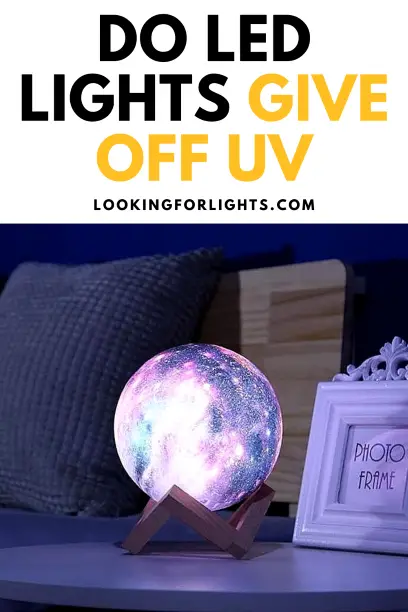Among the various light bulb options available in the market, LEDs are considered to be the most energy-efficient light bulbs. We often talk about the efficiency, durability, and heat generation in the case of LED lights. What about the kind of radiation emitted by them?
Do LED lights give off UV? It is important to know whether LED lights produce UV radiations because UV rays can have a great impact on the human body and cause burns, skin diseases, and irritations in the eyes. Let’s discuss in detail the lights that emit UV rays and lights that do not emit UV rays.
Table of Contents
Do LED Lights Give off UV?
No, the standard LED lights do not give off UV rays. However, some specialized LED lights are manufactured by companies that emit UV rays. These LEDs produce light in the UV region of the electromagnetic spectrum. They are designed to produce UV light for various purposes such as water filtration systems, bug-zapper lights, and so on. In these systems, UV radiation produced by the LED light bulbs is used to kill bacteria and germs and to attract mosquitos and insects.
Related article: Do LED Lights Attract Ants, Spiders, Roaches, And Other Bugs?
How Does an LED Light Work?
LED or light-emitting diodes are made of semiconductors. When the electric current is applied to these semiconducting materials, photons are emitted from the material which is responsible for the illumination produced in LED light bulbs. This process is known as electroluminescence. In other words, the LED light bulbs produce light when electrons jump from one side of the semiconductor to the other side where the electrons are deficient.
There is very little creation of UV rays in the form of blue light which is converted into white light by the phosphorus present in the LED bulbs. The phosphorus film acts as a filter so that a negligible amount of UV radiation is wasted in LED lights. Since LEDs do not require heat to produce light, these lights work at lower temperatures, unlike traditional light bulbs like halogen bulbs, incandescent bulbs, and compact fluorescent bulbs (CFLs).
What Lights Don’t Emit UV Rays?
Most of the bulbs available in the market for household use do not produce UV rays. Almost all LEDs, incandescent lamps, and sodium vapor bulbs emit very little ultraviolet rays. Let’s discuss each of these lights in detail.
Fluorescent Tubes
The fluorescent tubes work when the electrical current passes through the mercury vapor at low pressure. This leads to the production of UV rays. The UV rays fall upon the phosphorus coating present on the inside surface of the fluorescent tube. This phosphorus film then emits white light through the phenomenon of fluorescence. The light coming out of the tube consists of very little or almost no UV radiation as the phosphorus coating blocks most of this UV light.
Light Emitting Diodes (LEDs)
The light-emitting diodes or LEDs produce monochromatic light. It is because the semiconductor material gives off a single color of light when the electrons inside the material are excited by the current supplied. The UV content of the light produced by the LED bulb is blocked by the phosphorus coating of the bulb. Therefore, LED light bulbs do not emit any UV rays.
Incandescent bulbs (standard)
In incandescent light bulbs, there is a filament made up of tungsten that heats up due to electric current passing through it. When the filament heats up enough, it glows and produces white light. The spectrum of light emitted by incandescent bulbs is very wide and contains some UV region of the electromagnetic spectrum. The heating of the filament hence generates UV. However, incandescent bulbs are designed in such a way that they emit minimal or no UV light.
Sodium Vapor Lamps
Sodium Vapor lamps are generally used in street lights where enormous amounts of lighting are required. These types of lamps are extremely efficient in energy saving as well as brightness. They emit no UV light as the range of light spectrum emitted by them is mainly concentrated in the yellow region.
What Lights Do Emit UV Rays?
The ultraviolet light is invisible to humans as it falls out of the visible region and has a short wavelength. Direct exposure to UV light can have severe impacts on human health. However, there are some areas where UV light is desirable. For example, reptile lamps, water purifiers, HVAC systems, and so on. In addition, the sun being a natural source of UV light helps the body to get Vitamin D. Therefore, there are some lights designed to emit UV rays to suit these purposes.
Fluorescent bulbs
The compact fluorescent bulbs (CFLs) emit UVA light which can affect human skin and eyes when used for a long period. The UVA light is emitted in very small amounts and it doesn’t have any immediate impact on human health.
UVB Lights
UVB lights emit UV and are used in reptile basking lamps. The reptiles and amphibians need UV light for the metabolization of calcium.
Sunlight
Sun is the natural source of UV light. The entities on the planet earth receive controlled and filtered UV light from the sun because of the ozone layer. This light is very useful in several ways. For example, people keep food items out in the sun to kill bacteria present in them. But in recent times, due to the ozone layer getting punctured, direct UV light is entering some parts of the world.
Tanning Bulbs
These light bulbs are used in tanning beds. Tanning bulbs emit both kinds of UV light, UVA and UVB. Although it can cause skin damage and cancer in human beings, it is very beneficial in Vitamin D production and treating other disorders like seasonal affective disorder.
Conclusion

The typically LED light does NOT emit any amount of ultraviolet rays. However, there are specialized versions of the LED light that DO emit UV rays that are designed for water filtration systems, bug-zapper lights, etc.
While LEDs do NOT emit UV lights, the lights that do and that you should limit your exposure to are fluorescent bulbs, UVB lights, tanning bulbs, and of course, sunlight.
The lights that Emit very little UV light, or non at all, include LEDs, fluorescent tubes, standard incandescent bulbs, and sodium vapor lamps. You shouldn’t have to worry about being exposed to any of these types of lights.
